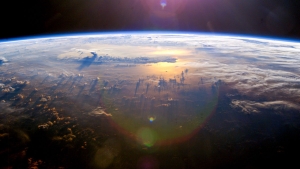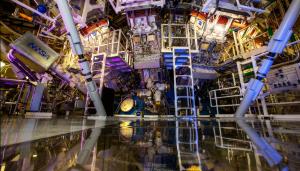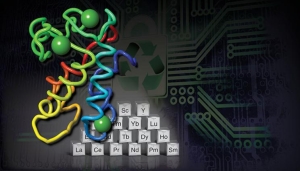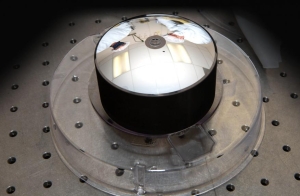LAB REPORT
Science and Technology Making Headlines
July 24, 2020


Clouds aren’t expected to dampen global warming — one reason why the planet is likely to respond sharply to carbon emissions. Image courtesy of ISS Expedition 7 Crew/EOL/NASA.
A clearer image of Earth’s destiny
It seems like such a simple question: How hot is Earth going to get? Yet for 40 years, climate scientists have repeated the same unsatisfying answer: If humans double atmospheric carbon dioxide (CO2) from preindustrial levels, the planet will eventually warm between 2.7-8.1˚Fahrenheit — a temperature range that encompasses everything from a merely troubling rise to a catastrophic one.
Now, in a landmark effort, a team of 25 scientists including those from Lawrence Livermore has significantly narrowed the bounds on this critical factor, known as climate sensitivity. The assessment, conducted under the World Climate Research Programme (WCRP) and published this week, relies on three strands of evidence: trends indicated by contemporary warming, the latest understanding of the feedback effects that can slow or accelerate climate change and lessons from ancient climates.
They support a likely warming range of between 4.1-8.1˚F. The takeaway from the report: A doubling of CO2 all but guarantees warming of more than 4.1°F.


The National Ignition Facility at Lawrence Livermore National Laboratory can simulate the conditions of a nuclear weapon. Photo by Jason Laurea/LLNL.
A different perspective on testing
Seventy-five years after the first explosive nuclear tests, sophisticated virtual testing allows American physicists to understand these weapons better than ever.
Today, the nation’s nuclear weapons research is focused on reliability testing and maintenance of the roughly 4,000 active warheads in its arsenal, a program broadly referred to as “stockpile stewardship.” After the test ban in 1996, the U.S .government lavished funding on the new stewardship program to keep the nation’s weapons up to snuff.
At the heart of the U.S. stockpile stewardship program is Lawrence Livermore National Laboratory. It’s home to the National Ignition Facility, which uses the most energetic laser in the world to recreate the conditions found in the heart of an exploding nuclear bomb. “It’s not so much that it replaces nuclear testing, but it’s a very different, richer perspective on what’s happening in an operating weapon,” says Kim Budil, principal associate director or the Weapons and Complex Integration directorate at Livermore.
Virtualization now allows scientists to dig deeper into the physics of the bomb.


Lanmodulin, a small protein, is a bio-sourced alternative to extract, purify and recycle rare earth elements from various sources, including electronic waste. Illustration by Thomas Reason/LLNL.
E-waste is mmm, mmm good
Lawrence Livermore researchers have designed a new process in which an e-waste-eating protein can extract rare earth elements (REE). It could offer a new avenue toward a more diversified and sustainable REE sector for the United States.
The protein, lanmodulin, enables a one-step extraction and purification of REEs from complex metal mixtures, including electronic waste and coal byproducts.
REEs are essential for American competitiveness in the clean energy industry because they are used in many devices important to a high-tech economy and national security, including computer components, high-power magnets, wind turbines, mobile phones, solar panels, superconductors, hybrid/electric vehicle batteries, LCD screens, night vision goggles and tunable microwave resonators.
To date, the chemical processes to extract and purify REEs are complex and harmful to the environment. Extracting or recycling REE from new sources, like electronic waste and coal byproducts, while using natural products, like lanmodulin, could be a cleaner alternative.


A telescope, dubbed V4 and an identical twin to this one, flew on LLNL’s GEOstare1 mission, where it was employed to demonstrate the utility of nanosatellites for space situational awareness.
It’s a small world
Researchers today are looking to stretch budgets, so they are building nanosatellites (about the size of a large shoebox and weighing less than 22 lbs.) and microsatellites (about the size of a dorm refrigerator and weighing several hundred pounds).
When spacecraft are that small, space (volume) and weight become even more critical and must be used sparingly. To make the most of the limited payload on these smaller satellites, researchers at Lawrence Livermore National Laboratory are developing a small monolithic telescope (MonoTele).
It consists of a single slab of fused silica, letting it act as an optic lens without mirrors. Instead, optical shapes and reflective coatings on the ends of the block turns it into a solid telescope. It never needs to be aligned, greatly simplifying design while minimizing size, weight and power needs. With far fewer moving parts, it is more durable and less likely to be damaged in flight.
MonoTele space telescopes ranging in size from one inch (called the minimonolith) to 14 inches have been built and tested. Several have already flown in space and performed well. Going forward, they will be used in nano satellites for observing Earth, establishing situational awareness and navigation.


LLNL scientists and collaborators determined how chemical elements behave in the interiors of planets like Neptune. Image courtesy of NASA.
Elemental discovery
There are giants among us — gas and ice giants to be specific. They orbit the same star, but their environmental conditions and chemical makeup are wildly different from those of Earth. These enormous planets — Jupiter, Saturn, Neptune and Uranus — can be seen as natural laboratories for the physics of matter at extreme temperatures and pressures.
An international team that includes scientists from Lawrence Livermore National Laboratory has developed a new experimental setup to measure how chemical elements behave and mix deep inside icy giants, which could offer insights into the formation and evolution of planetary systems. What they learn also could guide scientists hoping to harness nuclear fusion, which produces conditions similar to those in our sun, as a new source of energy.
In this most recent experiment, optical laser beams launched a shock wave in a plastic sample made up of carbon and hydrogen. As the shock wave moved through the material, the researchers observed it by hitting the shocked regions with X-ray photons that scattered both backward and forward off electrons in the sample.
One set of scattered photons revealed the extreme temperatures and pressures reached in the sample, which mimic those found 10,000 kilometers beneath the surface of Uranus and Neptune.





